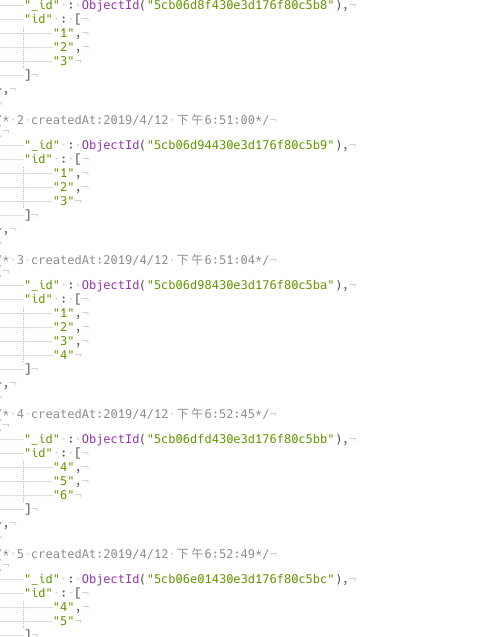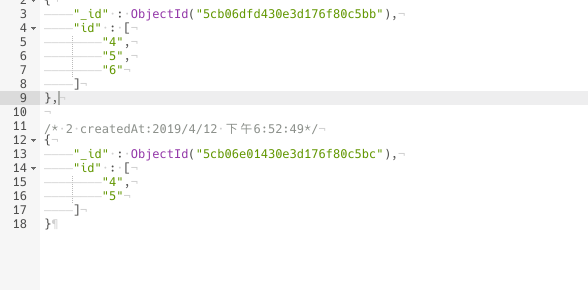1.mongodb——查询文档内部属性以及数组
文档格式:
"mapData": {
"children": [
{
"expectedYear": 2021,
"gender": 1,
"dob": "2010-10-10",
"name": "Alice",
"expectedGrade": "g1"
},
{
"expectedYear": 2021,
"gender": 1,
"dob": "2014-10-10",
"name": "Tom",
"expectedGrade": "g1"
}
],
"scheduleId": 12,
"contacts": [
{
"phone": "137222",
"name": "Elbem",
"email": "aab@niub.com"
},
{
"phone": "1373322",
"name": "Tonny",
"email": "aabc@niub.com"
}
],
"status": 10
},
"formCategory": null,
"creatorId": 4,
"creatorType": "alpha",
"campusId": 1,
"tenantId": 1,
"delFlag": 0
}查询方式:
Query query = new Query();
query.addCriteria(Criteria.where("mapData.scheduleId").in(ids));
if(status == -3){//不等于-3的时候按照状态获取
log.info("no status ",status);
}else{
//等于-3的时候获取全部
query.addCriteria(Criteria.where("mapData.status").in(status));
}
int totalSum = Integer.valueOf(mongoTemplate.count(query, CustomFormMongoEntity.class, MongoUtils.getTenantCollName(ParentPrivateController.COLLECTION_NAME))+"");
query.skip((page.getCurrent()-1)*page.getSize()).limit(Integer.valueOf(page.getSize()+""));2.让mongoDB也能使用in查询
Query query = new Query();
//Criteria c = new Criteria();
query.addCriteria(Criteria.where("bid").in(ids));
sum = Integer.valueOf(mongoTemplate.count(query, BookChapterMongo.class)+"");3.mongodb中使用$in和$all的区别$or操作符$and操作符
需求1:
查询出包含1或者包含4的数据
db.user.find({ id : { $in : [“1”,“4”] } } );
查询得到:
需求2:
查询出同时包含4和5的数据,这时就不能使用i n 来 进 行 查 询 了 , 因 为 i n 只 能 查 询 单 值 , 但 在 m o n g o d b 中 还 存 在 in来进行查询了,因为in只能查询单值, 但在mongodb中还存在in来进行查询了,因为in只能查询单值,但在mongodb中还存在all操作符,用于查询整个
db.user.find( { id: { $all:[“4”,“5”] } } )
得到结果:
总结:in只能查不重复的all可以查重复的。
4.mongodb查询的语法(大于,小于,大于或等于,小于或等于等等)
1 ) . 大于,小于,大于或等于,小于或等于
$gt:大于
$lt:小于
$gte:大于或等于
$lte:小于或等于
例子:
db.collection.find({ "field" : { $gt: value } } ); // greater than : field > value
db.collection.find({ "field" : { $lt: value } } ); // less than : field < value
db.collection.find({ "field" : { $gte: value } } ); // greater than or equal to : field >= value
db.collection.find({ "field" : { $lte: value } } ); // less than or equal to : field <= value
如查询j大于3,小于4:
db.things.find({j : {$lt: 3}});
db.things.find({j : {$gte: 4}});
也可以合并在一条语句内:
db.collection.find({ "field" : { $gt: value1, $lt: value2 } } ); // value1 < field < value
2) 不等于 $ne
例子:
db.things.find( { x : { $ne : 3 } } );
3) in 和 not in ($in $nin)
语法:
db.collection.find( { "field" : { $in : array } } );
例子:
db.things.find({j:{$in: [2,4,6]}});
db.things.find({j:{$nin: [2,4,6]}});
4) 取模运算$mod
如下面的运算:
db.things.find( "this.a % 10 == 1")
可用$mod代替:
db.things.find( { a : { $mod : [ 10 , 1 ] } } )
5) $all
$all和$in类似,但是他需要匹配条件内所有的值:
如有一个对象:
{ a: [ 1, 2, 3 ] }
下面这个条件是可以匹配的:
db.things.find( { a: { $all: [ 2, 3 ] } } );
但是下面这个条件就不行了:
db.things.find( { a: { $all: [ 2, 3, 4 ] } } );
6) $size
$size是匹配数组内的元素数量的,如有一个对象:{a:["foo"]},他只有一个元素:
下面的语句就可以匹配:db.things.find( { a : { $size: 1 } } );
官网上说不能用来匹配一个范围内的元素,如果想找$size<5之类的,他们建议创建一个字段来保存元素的数量。
You cannot use $size to find a range of sizes (for example: arrays with more than 1 element). If you need to query for a range, create an extra size field that you increment when you add elements.
7)$exists
$exists用来判断一个元素是否存在:
如:
db.things.find( { a : { $exists : true } } ); // 如果存在元素a,就返回
db.things.find( { a : { $exists : false } } ); // 如果不存在元素a,就返回
8) $type
$type 基于 bson type来匹配一个元素的类型,像是按照类型ID来匹配,不过我没找到bson类型和id对照表。
db.things.find( { a : { $type : 2 } } ); // matches if a is a string
db.things.find( { a : { $type : 16 } } ); // matches if a is an int
9)正则表达式
mongo支持正则表达式,如:
db.customers.find( { name : /acme.*corp/i } ); // 后面的i的意思是区分大小写
10) 查询数据内的值
下面的查询是查询colors内red的记录,如果colors元素是一个数据,数据库将遍历这个数组的元素来查询。db.things.find( { colors : "red" } );
11) $elemMatch
如果对象有一个元素是数组,那么$elemMatch可以匹配内数组内的元素:
> t.find( { x : { $elemMatch : { a : 1, b : { $gt : 1 } } } } )
{ "_id" : ObjectId("4b5783300334000000000aa9"),
"x" : [ { "a" : 1, "b" : 3 }, 7, { "b" : 99 }, { "a" : 11 } ]
}$elemMatch : { a : 1, b : { $gt : 1 } } 所有的条件都要匹配上才行。
注意,上面的语句和下面是不一样的。
> t.find( { "x.a" : 1, "x.b" : { $gt : 1 } } )
$elemMatch是匹配{ "a" : 1, "b" : 3 },而后面一句是匹配{ "b" : 99 }, { "a" : 11 }
12) 查询嵌入对象的值
db.postings.find( { "author.name" : "joe" } );
注意用法是author.name,用一个点就行了。更详细的可以看这个链接: dot notation
举个例子:
> db.blog.save({ title : "My First Post", author: {name : "Jane", id : 1}})
如果我们要查询 authors name 是Jane的, 我们可以这样:
> db.blog.findOne({"author.name" : "Jane"})
如果不用点,那就需要用下面这句才能匹配:
db.blog.findOne({"author" : {"name" : "Jane", "id" : 1}})
下面这句:
db.blog.findOne({"author" : {"name" : "Jane"}})
是不能匹配的,因为mongodb对于子对象,他是精确匹配。
13) 元操作符 $not 取反
如:
db.customers.find( { name : { $not : /acme.*corp/i } } );db.things.find( { a : { $not : { $mod : [ 10 , 1 ] } } } ); mongodb还有很多函数可以用,如排序,统计等,请参考原文。
5.mongodb根据_id删除
@GetMapping("/id")
//@PreAuthorize("@pms.hasPermission('eaorg_vstbooked_del')")
public R removeById(@RequestParam(value = "id") String id) {
Query query=new Query(Criteria.where("_id").is(id));
long count = mongoTemplate.remove(query,Map.class,"集合名称").getDeletedCount();
return R.ok(count);
//return R.ok(vstBookedService.removeById(id));
}6.mongodb根据_id修改
public R updateById(@RequestBody CustomFormMongoEntity visitBookMongoEntity) {
Query query = new Query();
query.addCriteria(Criteria.where("_id").is(visitBookMongoEntity.getId()));
Document doc = new Document();
mongoTemplate.getConverter().write(visitBookMongoEntity,doc);
Update update = Update.fromDocument(doc,"_id");
UpdateResult upsert = mongoTemplate.upsert(query, update, MongoUtils.getTenantCollName(ParentPrivateController.COLLECTION_NAME));
//return R.ok(vstBookedService.updateById(vstBooked));
return R.ok(upsert);
}7.mongodb根据添加
mongoTemplate.save(visitBookMongoEntity,"集合名称")8.mongodb分页
Query query = new Query();
query.addCriteria(Criteria.where("mapData.scheduleId").in(ids));
if(status == -3){/
log.info("no status ",status);
}else{
query.addCriteria(Criteria.where("mapData.status").in(status));
}
int totalSum = Integer.valueOf(mongoTemplate.count(query, CustomFormMongoEntity.class, MongoUtils.getTenantCollName(ParentPrivateController.COLLECTION_NAME))+"");
query.skip((page.getCurrent()-1)*page.getSize()).limit(Integer.valueOf(page.getSize()+""));
List<CustomFormMongoEntity> customFormMongoEntities = mongoTemplate.find(query, CustomFormMongoEntity.class, MongoUtils.getTenantCollName(ParentPrivateController.COLLECTION_NAME));
page.setRecords(customFormMongoEntities);
page.setTotal(totalSum);
return R.ok(page);
最后
以上就是喜悦路灯最近收集整理的关于mongodb查询文档内部属性以及数组1.mongodb——查询文档内部属性以及数组2.让mongoDB也能使用in查询3.mongodb中使用$in和$all的区别$or操作符$and操作符4.mongodb查询的语法(大于,小于,大于或等于,小于或等于等等)的全部内容,更多相关mongodb查询文档内部属性以及数组1.mongodb——查询文档内部属性以及数组2.让mongoDB也能使用in查询3.mongodb中使用$in和$all内容请搜索靠谱客的其他文章。








发表评论 取消回复